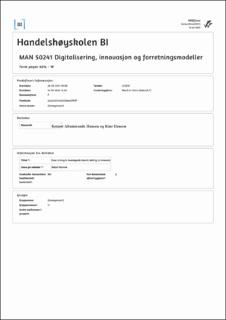- How strong is AvantGarde Search ability to innovate- And how can innovation capabilities defined by the methodology “scalable learning” affect the company's ability to innovate in a rapidly changing environment?
Master thesis
Permanent lenke
https://hdl.handle.net/11250/3031564Utgivelsesdato
2022Metadata
Vis full innførselSamlinger
Sammendrag
Efficiency, Key Performance Indicators and incentives for performance, measured towards successfully solving assignments and contracts given by customers, leaves little time and interest for taking a step back and preparing for the future. This is the world of professional service providers. Billing hours to secure cash flow and increase salary is the main objective. In the long run this is a risk for not surviving the changing environment due to new technology and business models.
So how can we prepare for the future? Basically, we need a model for innovative activities and identify boundaries that restrict such activities. This will allow the company to remove the boundaries and prepare for the future demands of the industry or take the risk of staying comfortably numb and run business as usual. The model we aim to invent is based on what gives the most value to the customers, as we believe this is the key for success. This might not be the best option for the revenue in the short term, but it increases the chance of being in the lead when it comes to innovation in the industry and surviving in a changing business environment.
This paper interacts with several of the 10 questions in the program: Digitalization, innovation and business models. The most important one being “How to give innovation and digital transformation higher priority in the organisation”. We have also looked into “What types of innovation and business models can the organisation use to increase value” and “How can digitalization of multiple-sided platforms create value” and “How to create a stronger culture for changes and innovation”. Understanding the paradox of innovation culture, and the knowledge on how to create a good culture is desired but has not been attended to with a strong focus. This culminates into one important question “What companies become winners, and why” This paper will not select and focus on a particular question from the curriculum, other than we have identified them.
If one should identify a mechanism for this paper, it would be “By focusing on scaling learning instead of focusing on efficiency alone, innovation through strong interaction with customers and disciplined management can change and reinforce
the business model, given boundaries for doing so are removed” This is the mechanism we aim to say something about in this paper.
The foundation for innovating is “Scalable Learning” as introduced by Hagel III. This is a high-level of interaction with customers to create new business models based on what gives value to them. The paper aims at an industry, exemplified by a company in the recruitment industry, where main focus is efficiency, key performance indicators and little interaction with the customer to evaluate optional methodologies. The journey from a focus on efficiency to innovation through scalable learning is a process we have sought to solve through factors increasing the capability for innovation. We have been looking into: innovation culture, change orientation and co-creation as factors to prepare for how to deliver service by understanding the customer’s needs. Digital maturity and innovation strategy are factors chosen to enable the company to utilise technology to develop people’s capabilities. Those two factors, Understanding the customers’ needs and utilising technology is the foundation for scalable learning, where one drives new knowledge creation through practice by addressing challenges never found before. We also looked at the factor absorptive capacity, as we deemed this critical to validate if a company at all is capable of preparing and what the company needs for this journey.
Through these factors we aimed at creating a model that allows the organisation to be prepared for this journey. And we identified boundaries we believe are typical for the industry that needs to be addressed prior to allocating resources to do so. With those boundaries there is a risk one might not secure a successful outcome.
What we found is that the daily hunt for efficiency leaves no resources to allocate for innovation activities. Also, economic incentives restrict the interest of participating in such. Another boundary is absorptive capacity. In our case we found traces that implies weak absorptive capacity, and this implication prevented ideas from employees to surface. This could be connected to dominant logic, as discovered from the management side, but identifying dominant logic was not part of this paper. We suggest dominant logic should be included in every company's future work. We also found that the company in our paper was partly prepared, in
Side iv
relation to the other factors, to go from scalable efficiency alone to scalable learning. It lacked the right resources, processes, plans and structure to do so. But this is considered a minor hindrance and can easily be established if the company decides to do so.
Through this work the authors have strengthened our view on the importance of creating value by involving the customers. It should be in everyone’s interest to do so. And once this starts, the ones not adapting might not survive. This paper is in english, as Avantguard searches webpage. The reason for this is that the company highly value: diversity, inclusion and are preoccupied by today's globalisation of recruitment.
Beskrivelse
Executive Master of Management i Digitalisering, innovasjon og forretningsmodeller – i en digital tid fra Handelshøyskolen BI, 2022
